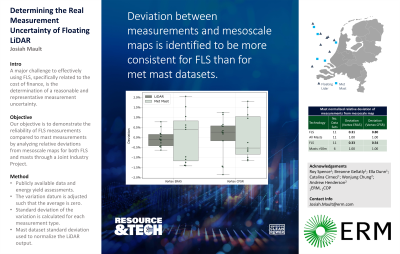Back

Determining of the Real Measurement Uncertainty of Floating LiDAR
Tuesday, October 1, 2024
5:00 PM – 6:00 PM MST
Location: Regency D


Josiah Mault
Principal Consultant
ERM
Boston, Massachusetts
Poster Presenter(s)
Presentation Description: Floating LIDARs (FLS) have become an established technology and have become the measurement method of choice for offshore windfarm wind resource assessments. The Carbon Trust provided strong and consistent support for the maturation of the technology, with the IEA and now the IEC furthering industry guidance; however, the technology is still limited in commercial uses.
A major challenge to effectively using FLS, specifically related to the cost of finance, is the determination of a reasonable and representative measurement uncertainty. Historically, the wind industry has been cautious with new wind measurement technologies to maintain the investors and lenders confidence. This has been implemented in applying conservative uncertainties to the wind measurement data, resulting in apparently low confidence in the wind climate, even when an on-site FLS wind measurement campaign has been undertaken.
Reconciliation exercises are commonly carried out by consultants for both onshore and offshore windfarms, validating the estimated energy production against the operational performance of the windfarms, with the distribution of the deviations being compared with the stated uncertainty of the estimates. A similar approach can be undertaken by comparing wind measurement campaigns within a region and investigate whether the deviations align with the stated uncertainty of the wind measurements.
This presentation will show the results of an in-depth study based on more than a dozen FLS measurements globally to provide robust conclusions and recommendation of FLS measurement uncertainty.
A major challenge to effectively using FLS, specifically related to the cost of finance, is the determination of a reasonable and representative measurement uncertainty. Historically, the wind industry has been cautious with new wind measurement technologies to maintain the investors and lenders confidence. This has been implemented in applying conservative uncertainties to the wind measurement data, resulting in apparently low confidence in the wind climate, even when an on-site FLS wind measurement campaign has been undertaken.
Reconciliation exercises are commonly carried out by consultants for both onshore and offshore windfarms, validating the estimated energy production against the operational performance of the windfarms, with the distribution of the deviations being compared with the stated uncertainty of the estimates. A similar approach can be undertaken by comparing wind measurement campaigns within a region and investigate whether the deviations align with the stated uncertainty of the wind measurements.
This presentation will show the results of an in-depth study based on more than a dozen FLS measurements globally to provide robust conclusions and recommendation of FLS measurement uncertainty.
